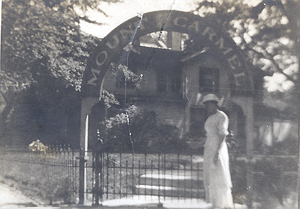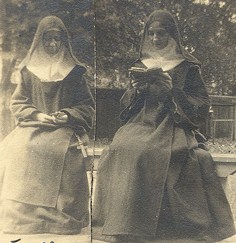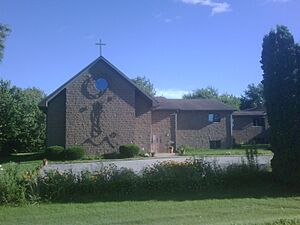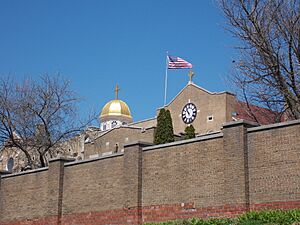Regina Coeli Monastery facts for kids
Quick facts for kids |
|
|
Regina Coeli Monastery
|
|
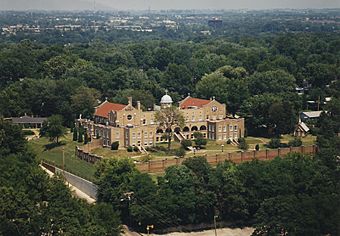 |
|
| Location | 1401 Central Avenue Bettendorf, Iowa |
|---|---|
| Area | 2 acres (0.81 ha) |
| Built | 1916 |
| Architect | Arthur Ebeling |
| Architectural style | Mission/Spanish Revival Late Gothic Revival Romanesque |
| NRHP reference No. | 93001590 |
| Added to NRHP | January 28, 1994 |
The Regina Coeli Monastery is a special old building in Bettendorf, Iowa, United States. It was added to the National Register of Historic Places in 1994 because of its history. Today, this building is known as The Abbey Center, which helps people with addiction. The Discalced Carmelite nuns, who originally built and lived in the monastery, moved to a new home in Eldridge, Iowa in 1975. The monastery first started in Davenport, Iowa.
Contents
History of the Monastery
Starting in Davenport
The first Discalced Carmelite nuns came to Davenport from Baltimore on November 23, 1911. Among them were Mother Clare of the Blessed Sacrament and Mother Aloysius of Our Lady of Good Counsel. Mother Clare's brother, Joseph Nagle, helped bring the Carmelite nuns to Davenport. Other bishops in the Midwest had not been able to welcome them. But Joseph Nagle convinced Bishop Davis to let the nuns come to his area.
The Carmel monastery officially began on November 24, 1911. They started in a small house at 15th and Brady Streets. This house was next to the bishop's home. He would often hold Mass for the nuns there. Mother Clare was chosen as the leader, or prioress, of the new Carmel.
The small house soon became too crowded. So, an addition was built on land given by Bishop Davis. This new part included a chapel, a choir area for the nuns, and six bedrooms. The chapel was built in the Late Gothic Revival style. The first Mass in the new chapel was on Christmas Eve, 1912. It was officially opened on February 11, 1913. The chapel was called Pater Noster Chapel, and the monastery was named after the prophet Elijah.
Moving to Bettendorf
After the new chapel was finished, plans began to make the monastery even bigger. The Carmelite rules said that 21 nuns should each have their own room. But the land on Brady Street was not big enough for this expansion. Mother Clare thought that Bettendorf might be a good place.
Pius Mohr found land on the hills above Bettendorf. Bishop Davis bought this land on April 3, 1915. The property was surrounded by woods and farms. This quiet setting was much better for the nuns' peaceful life than the city.
Arthur Ebeling, who designed the chapel addition, was chosen to design the new Carmel. He had also designed homes for the families who helped fund the monastery. These included the Walsh, Kahl, and Bettendorf families. Joseph Bettendorf's new house was even nearby. This was a very big project for Ebeling. The new site was far from city streets and electricity. The town provided water, and a telephone was added later. A professional landscaper designed the gardens. The nuns moved into their new home on June 29, 1916. The monastery's name was changed to Regina Coeli, which means "Queen of Heaven."
On November 24, 1916, the monastery bells were blessed. The large bell was named Vox Domini (Voice of the Lord), and the small bell was named St. Joseph. The chapel from the old Davenport Carmel was carefully taken apart and rebuilt at the new Bettendorf location. It was opened again in 1919 and kept its original name, Pater Noster. The room that used to be the chapel was divided into a library and a meeting room. The rest of the monastery was finished in 1921, and the surrounding wall was completed in 1937.
Life in a Carmel is usually very quiet. However, some events did break the silence. At one point, a group called the Ku Klux Klan caused trouble near the monastery. They tried to scare the nuns, but instead, the people of the town stood up for the nuns. The police helped bring peace back to the area.
Carmel monasteries usually have a limit of 21 nuns. When a community grew too large, they would start a new Carmel in another place. The Bettendorf Carmel helped start three new monasteries:
- In 1922, a Carmel was started in New Albany, Indiana. It later moved to Indianapolis.
- In 1940, another Carmel began in Milwaukee. This one later moved to Pewaukee, Wisconsin.
- In 1961, the Sioux City, Iowa Carmel was established.
In the 1960s, things began to change. The number of nuns at the Bettendorf Carmel started to decrease. The nuns who remained found it hard to take care of such a large building. So, they decided they needed a smaller place. They bought 10 acres of farmland near Eldridge, Iowa. The bodies of the nuns who had passed away were moved from the monastery to Mt. Calvary Cemetery in Davenport.
The Bettendorf Carmel was sold to an Evangelical Christian Church. In 1978, the Franciscan Brothers of Christ the King bought the building. They renamed it St. Francis Monastery. They used it for retreats and events. The brothers later sold the building. In 1993, the new owners turned it into a fancy hotel called the Abbey Hotel. In 2009, the hotel closed, and the building became The Abbey Center, which helps people with addiction.
The Eldridge Carmel
The new Carmel in Eldridge was ready for the nuns to move in on November 24, 1975. This was 64 years after the Carmel first started in the Davenport area. The large bell from the old monastery was moved to a new bell tower at the Eldridge property. The new facility allowed for more space, and it was expanded twice. A new chapel, called Holy Trinity, and more living and work areas were added in the 1980s. In the 1990s, another addition was made for more living space.
However, the number of nuns in the community continued to decrease. By 2015, the nuns knew they needed to make another change. They started looking for a new home in 2019. They decided they no longer wanted to own property. Through their connection with the Sisters of St. Francis of Clinton, they found a solution. The Carmelites moved to the Franciscan motherhouse, called the Canticle, in Clinton, Iowa, on September 28, 2020. Their property near Eldridge was then put up for sale.
Building Design
Arthur Ebeling used the Baltimore Carmel as his inspiration for the design. He blended several architectural styles. The two-story archway on the south side looks like the columns found in Italian Romanesque buildings. The small dome on top is also influenced by Romanesque and even Muslim designs. He used the Mission style in the stepped roofline. As mentioned before, the chapel is in the Gothic Revival style. The building is important because Ebeling was able to mix different Mediterranean architectural styles with modern American building methods.
The building itself is shaped like a double cross. It is made of gold brick with Bedford limestone trim. A small dome with a cross sits in the middle of the monastery's central part. Ebeling used the chapel's size to plan the rest of the building. This made the chapel fit perfectly into the larger structure. Also, the round window above the altar is matched by a round clock face on the east side of the monastery. A 10-foot-high wall, called a cloister wall, forms the southern edge of the property. On this wall are the Stations of the Cross. The garden inside the wall once had statues and a fountain.
Each new owner of the building made many changes inside to fit their needs. The Unity Church removed some of the decorative metalwork in the chapel. The Franciscans removed and built some walls. They also added modern things like carpet and a swimming pool. Some of these changes were undone when the building became a hotel in 1992, but most were not. During that hotel renovation, walls between some of the nuns' small rooms were removed to create larger hotel rooms.




